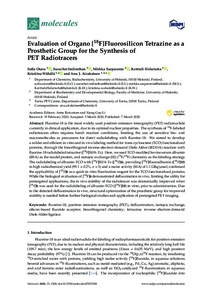Evaluation of organo [18F]fluorosilicon tetrazine as a prosthetic group for the synthesis of PET radiotracers
Sofia Otaru; Surachet Imlimthan; Mirkka Sarparanta; Kerttuli Helariutta; Kristiina Wähälä; Anu J. Airaksinen
https://urn.fi/URN:NBN:fi-fe2021042820914
Tiivistelmä
Fluorine-18 is the most widely used positron emission tomography (PET)
radionuclide currently in clinical application, due to its optimal
nuclear properties. The synthesis of 18F-labeled radiotracers
often requires harsh reaction conditions, limiting the use of sensitive
bio- and macromolecules as precursors for direct radiolabeling with
fluorine-18. We aimed to develop a milder and efficient in vitro and in
vivo labeling method for trans-cyclooctene (TCO) functionalized
proteins, through the bioorthogonal inverse-electron demand Diels-Alder
(IEDDA) reaction with fluorine-18 radiolabeled tetrazine ([18F]SiFA-Tz). Here, we used TCO-modified bovine serum albumin (BSA) as the model protein, and isotopic exchange (IE) (19F/18F) chemistry as the labeling strategy. The radiolabeling of albumin-TCO with [18F]SiFA-Tz ([18F]6), providing [18F]fluoroalbumin ([18F]10) in high radiochemical yield (99.1 ± 0.2%, n = 3) and a molar activity (MA) of 1.1 GBq/µmol, confirmed the applicability of [18F]6 as a quick in vitro fluorination reagent for the TCO functionalized proteins. While the biological evaluation of [18F]6
demonstrated defluorination in vivo, limiting the utility for
pretargeted applications, the in vivo stability of the radiotracer was
dramatically improved when [18F]6 was used for the radiolabeling of albumin-TCO ([18F]10)
in vitro, prior to administration. Due to the detected defluorination
in vivo, structural optimization of the prosthetic group for improved
stability is needed before further biological studies and application of
pretargeted PET imaging.
Kokoelmat
- Rinnakkaistallenteet [27094]
